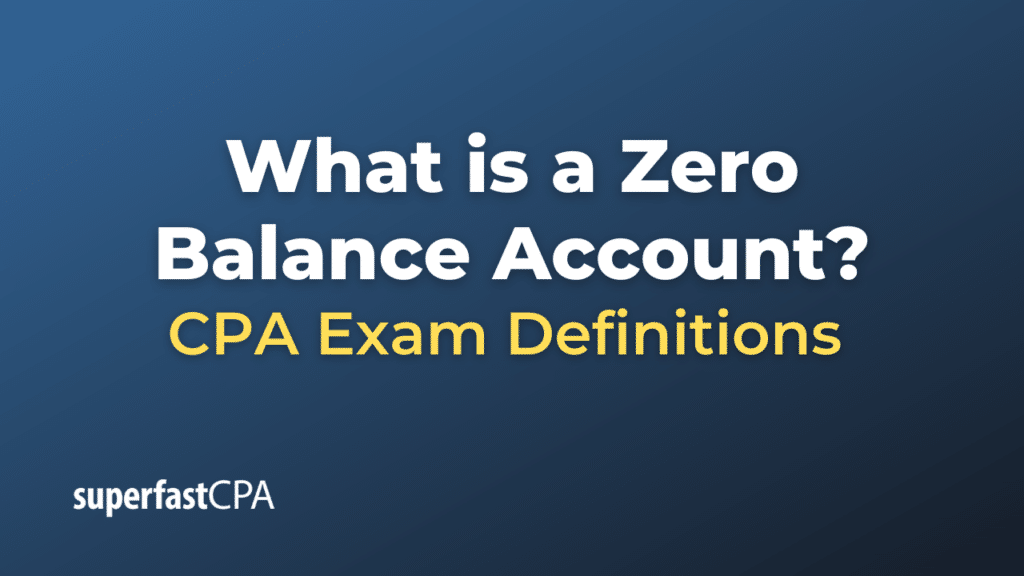Zero Balance Account
A Zero Balance Account (ZBA) is a type of business bank account that automatically transfers funds to and from a master account to maintain a zero balance at the end of each business day. The primary purpose of a ZBA is to eliminate excess balances in separate accounts and maintain greater control over disbursements. These accounts are commonly used in large organizations or complex business structures that require multiple sub-accounts for various departments, subsidiaries, or purposes.
How It Works
- Master Account: This is the primary account where all the funds are initially deposited. It’s the central hub for the financial resources of the company.
- Zero Balance Accounts: These are the sub-accounts tied to the master account, and they are used for specific operational purposes like payroll, expenses, or vendor payments.
- Automatic Transfers: At the end of each business day, any remaining balances in the ZBAs are transferred back to the master account, leaving them with a zero balance. Similarly, if a ZBA needs funds for transactions (like disbursements or checks to be cleared), the exact required amount is automatically transferred from the master account to cover these obligations.
Advantages
- Cash Concentration: All idle funds are concentrated in the master account, which can be used for investment opportunities or other needs.
- Improved Control: A ZBA structure makes it easier to control funds and track transactions, as each ZBA is typically used for a specific purpose.
- Efficiency: Automated transfers save time and administrative effort in manually transferring funds between accounts.
- Reduced Costs: By maintaining a zero balance in the sub-accounts, companies may reduce the service charges imposed by banks for maintaining minimum balances.
Example of a Zero Balance Account
Let’s walk through a simple example to illustrate how a Zero Balance Account (ZBA) might work in a real-world business setting.
Imagine a medium-sized company named “HealthyBites” that sells organic snacks online. They have a central bank account, referred to as the “Master Account,” and they decide to open three ZBAs for specific financial needs:
- Payroll Account: Used for employee salaries and benefits
- Operating Expenses Account: Used for utility bills, rent, and other recurring costs
- Vendor Payments Account: Used for paying suppliers and other vendors
Initial Scenario
- Master Account: Starts with a balance of $200,000.
- Payroll Account: $0 (because it’s a ZBA)
- Operating Expenses Account: $0 (because it’s a ZBA)
- Vendor Payments Account: $0 (because it’s a ZBA)
Example Transactions in One Business Day
- Payroll Time: HealthyBites needs to pay its employees a total of $40,000. The exact amount is automatically transferred from the Master Account to the Payroll Account to meet this need.
- Operating Expenses: HealthyBites has a combined utility bill and rent payment of $10,000 for the month. The exact amount is transferred from the Master Account to the Operating Expenses Account to cover these bills.
- Vendor Payments: HealthyBites needs to pay $15,000 to various vendors. Again, the exact amount is transferred from the Master Account to the Vendor Payments Account to pay the invoices.
End-of-Day Account Balances
- Master Account: $200,000 (Initial) – $40,000 (Payroll) – $10,000 (Operating Expenses) – $15,000 (Vendor Payments) = $135,000
- Payroll Account: Automatically reset to $0 at the end of the day, with any excess funds moved back to the Master Account.
- Operating Expenses Account: Automatically reset to $0 at the end of the day.
- Vendor Payments Account: Automatically reset to $0 at the end of the day.
Key Points
- By using ZBAs, HealthyBites ensures that funds are allocated only as needed, reducing the risk of leaving idle money in various sub-accounts.
- At the end of the day, any remaining funds in the ZBAs would be swept back to the Master Account, maintaining the zero balance in each ZBA.
- The Master Account retains the bulk of the funds, allowing for more centralized management and investment opportunities.
This is a simplified example but should give you an idea of how Zero Balance Accounts are commonly used in businesses for effective cash management.













